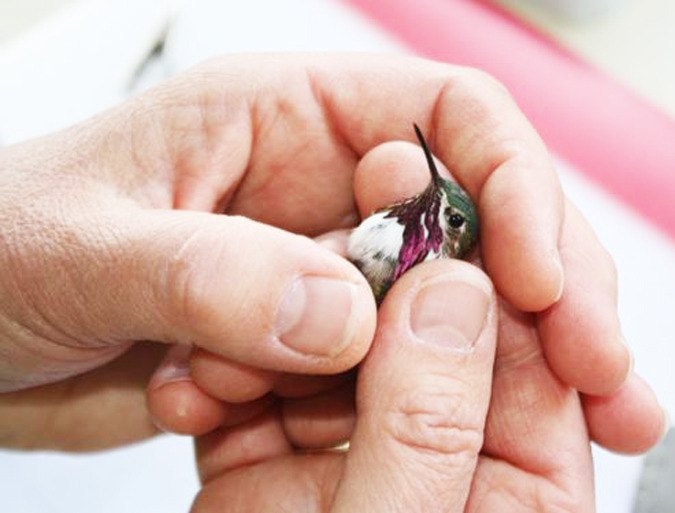Ten members of the Princeton Vermillion Forks Field Naturalists met Saturday May 28 and Sunday 29 at three sites to band hummingbirds. Alison Moran and Cam Finlay, who are master banders from the Rocky Point Bird Observatory in Victoria, BC, assisted them.
An exciting find was made on Saturday May 28. It turned out to be a hybrid bird which is a cross between a Calliope and Rufous Hummingbird. This was the first hybrid recorded in more than 20,000 birds banded by the Hummingbird Project of BC.
The Hummingbird Project of BC is linked with the “Hummingbird Monitoring Network”, studying hummingbirds in the USA and Mexico. Since hummingbirds are key pollinators in B.C. we must determine how they are managing and try to make changes to improve their population. With the information gathered, they can learn hummingbird migration routes, site fidelity, population structure (sex/age/health), when they arrive, breed and leave, and habitat requirements. Important information already learned is that the Rufous Hummingbird has suffered a steep decline of 6 per cent since the mid-1960’s, and are now on the species of concern list.
Banding hummingbirds takes patience, practice and a team of people to perform all the activities. You might be asking yourself by now ~ How do you band a hummingbird?
First we need a host who offers their home where the team can capture and process the birds. The site usually has a history of high visit rate at the feeders. A special mesh trap is placed around the hummingbird feeder and the bird is captured when it arrives to feed. A trained trapper handles the bird and passes the bird to the person who will apply a small numbered aluminum band to its leg. Many measurements and observations are taken including species, age and sex.
A scribe documents all observations on a data sheet and observes the status of the bird during processing. Finally, the bird is given a drink and released with as little handling as possible.
Nectar in feeders should be as close as possible to that provided by nature. The best sugar solution is one part white sugar to four parts water. Boil it for two minutes, let it cool and fill the feeder. Higher concentrations, although inviting to birds can cause sticky bills, difficulty preening and kidney damage. Feeders should be cleaned regularly and filled with fresh nectar. Never use brown sugar, honey, icing sugar, juice or artificial sugar since they can poison the birds. Artificial nectars are also prone to spoiling.
We wish to extend our thanks to those involved:
First to Madelon Schouton who has been instrumental in getting the VFFN club involved with the Hummingbird Project of B.C. for the past four years.
To Sue Elwell for hosting the group from Victoria in her home. Sue will be applying for a banding permit to enable our local group to band birds without the assistance of others.
To the three site hosts for generously opening their homes to our group, nourishing us and providing a banding site.
Lastly, we would like to thank all the volunteers from the Vermillion Forks Field Naturalists for their enthusiasm and assistance.
